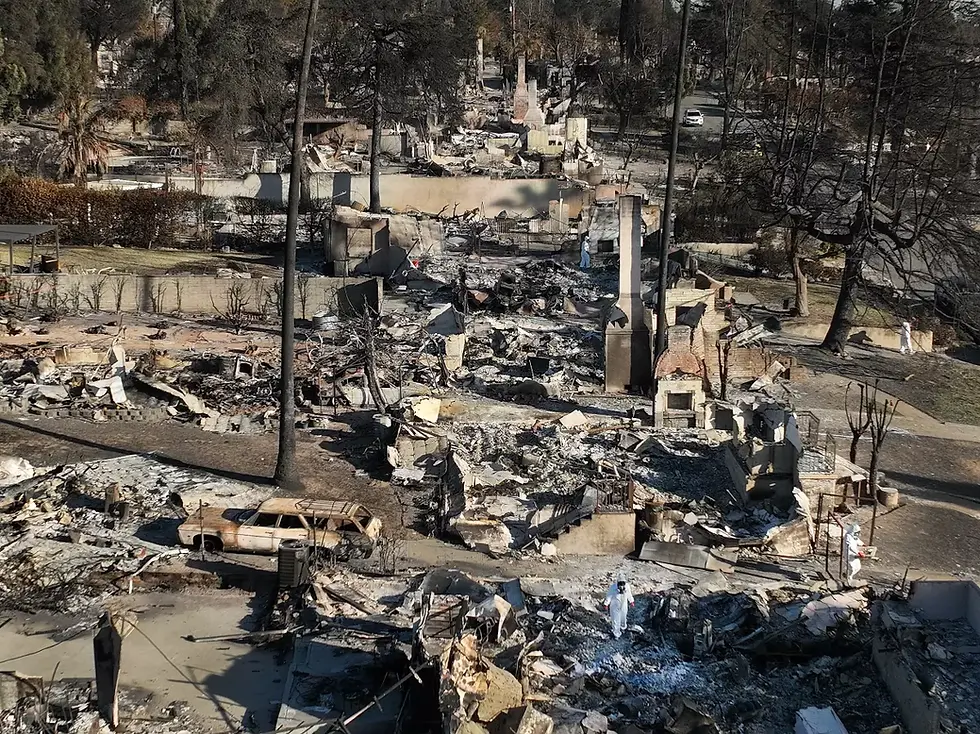The Wildfire of Insurance
- Brian
- Mar 14
- 4 min read
Article Type: Fact & Opinion
As climate change takes its toll on what generations of American businesses and families have come to know as “normal,” a very human side-effect is brewing: the ineffectiveness of responding to changing and growing disasters. First responders are ill-equiped to handle the scale and speed of these disasters. Governments are responding after events happen and struggling to get the proper aid where it needs to go. A separate, but related, side-effect of climate change is a growing movement for insurance companies to drop coverage for certain events and/or locations. This leaves families, many of which are often unable to cover the costs if disaster strikes, out in the cold.
Climate change has been occurring since the Earth was formed. There may have been periods of relative stability, but change is always occurring. The concept of what's normal and expected versus what nature has outlined are very different things. Most societies (perhaps all) across the globe are built around expectations that what happened yesterday will most likely happen again tomorrow. It is only when disaster strikes that sometimes, if the disaster is big enough, or if there are enough of the same in a row, that action is taken to adapt. Oftentimes those changes come too late for many families.
Most families in the United States rely on insurance to help them if a disaster occurs. And while insurance companies are busy hiking premiums, exiting types of business or markets, they are missing an opportunity to do good and make a long-term profit.
Insurance has been built on a model of evaluating risk, develop a premium, create conditions to minimize payouts, and pay only when forced to. Several, such as GEICO, have gained so much money from premiums and avoiding payouts, that they’ve created massive businesses and made their stockholders wealthy. But what about those they insure, or have now deemed too risky and leave exposed?

In early 2025, wildfire ripped through parts of Los Angeles, destroying homes and businesses. Firefighters on the ground and in the air had trouble dousing the flames. The inability of first responders to put it out quickly meant that it created a dire and disastrous situation that consumed hundreds of acres, homes, and buildings. That meant that people lost their homes, many of which did not have insurance or the right type of insurance to cover their losses. On first thought, many people view these areas of Los Angeles as rich. Most that live there are the average American: just trying to get by.
Early estimates show that the Los Angeles wildfires will cost between $95B - $116B*. Some estimates are as high as $250B**. In total, at least 29 people lost their lives. Beyond that financial impact, the more important factor is the impact to lives. Lives lost and lives forever changed by these events through emotional and physical distress.
WIldfires in the United States have gotten out of control in recent years. In 2014, wildfires burned roughly 3.5MM acres. In 2024, they burned 8.9MM acres. Whether a result of climate change or human actions, or a combination of both, we must all come together to address this.
The Idea
What if insurance companies, instead of taking a passive role, could take a more active one? A role that could lead them to being even more profitable in the long run, while protecting both people and property? That’s where my crazy idea comes in: industrial sprinkler systems. Have insurance companies collaborate with government to install sprinkler systems in high risk areas.
Sprinkler systems along roadways in high risk areas.
It may sound crazy. It may sound impossible. But, think for a moment: insurance companies shell out billions a year in premium payouts. Governments shell out billions each year in aid. Why not take that money and install industrial-grade sprinkler systems in high risk areas that can be turned on or off at a moments notice?
This solution won't prevent 100% of the cases. It may not even fully stop all wildfires. But it can do is help first responders, limit the amount of damage and spread, and give people a better chance to head for cover if needed.
As humanity moves into a realm where artificial intelligence is becoming more prominent and can help better predict when and where a disaster could happen, it is easy to forget the simple solutions that could have a more far-reaching impact.

Today's Decision, Tomorrow’s Impact
Finding new and creative ways to solve problems is a must in today's world. Remembering to look at both the simple (ie: sprinklers) and the complex (artificial intelligence) is critical. We cannot look to only one area to solve, or mitigate, problems. Yes, this idea I have presented will cost billions now, and significant dollars to maintain over time. But, look at the upside. The human cost of disasters, whether it be lost lives or mental and physical aguish of those left in the wake, is high. Every life saved is worth the money. And remember: money is a human problem, not a natural thing. Nature doesn't care about money or the time we've spent building something.
I, for one, believe it is worth spending $1B - $2B on sprinkler systems in high-risk areas in Los Angeles versus spending $95B or $250B to clean up. , spending even half that one time on sprinkler systems in these areas to prevent, or at least minimize, the impact of a future event is well worth the cost.
Every decision made by government officials, and those working in areas meant to protect people and property should ask themselves what the human impact is. If life takes a back seat to profit, then there is fundamentally something wrong. Let's rethink decisions, rethink how problems are approached, and have a positive impact on the lives around us.






Comments